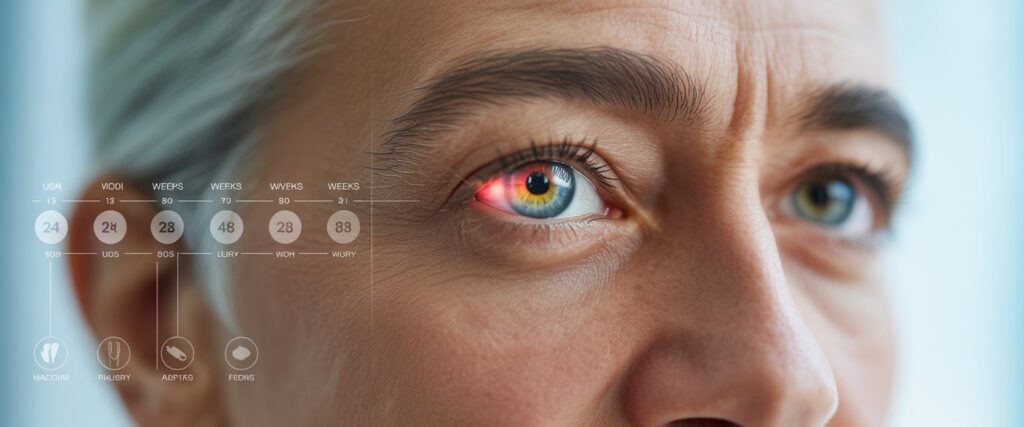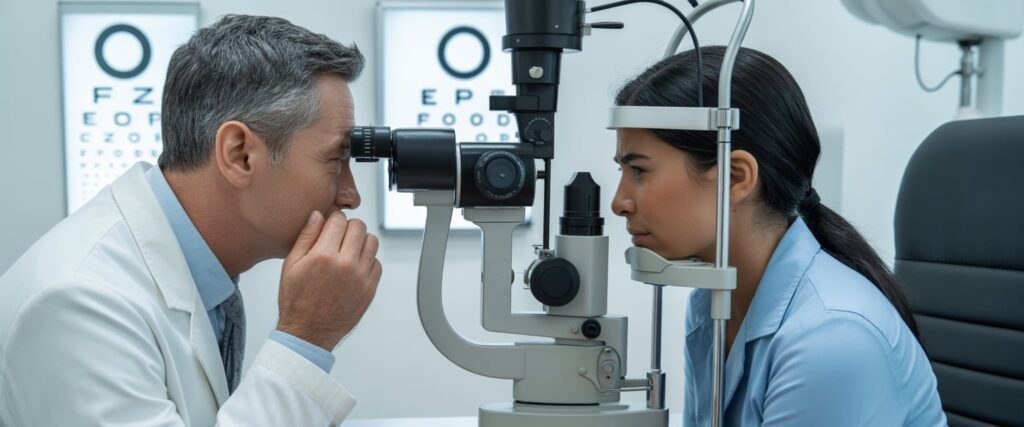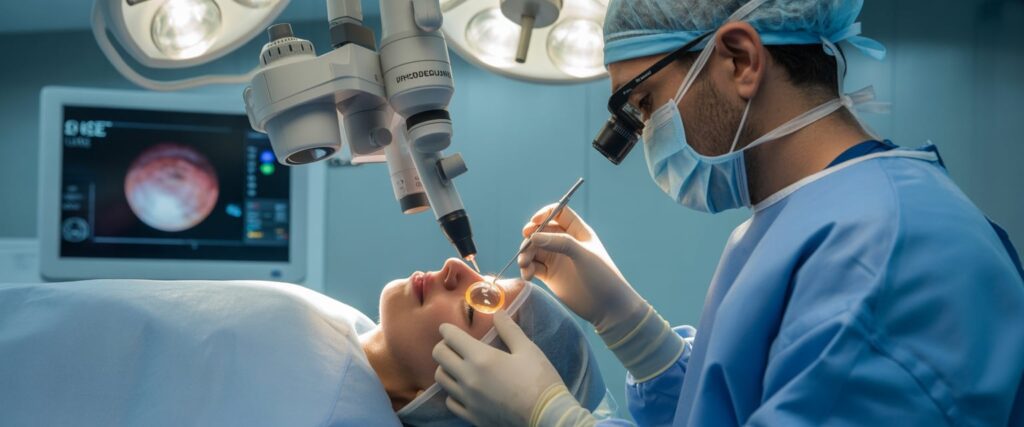Wondering “How Many Days Rest Is Needed After Cataract Surgery? Recovery Timeline & Tips” can make all the difference in achieving smooth, complication-free healing after your procedure. Cataract surgery may be quick and painless, but proper rest and aftercare are essential for restoring clear, healthy vision. Most patients recover rapidly with the right precautions—protecting the eye, managing medications, and avoiding strain during the early days. In this guide, we’ll explore “How Many Days Rest Is Needed After Cataract Surgery? Recovery Timeline & Tips” in detail, helping you understand what to expect, how to take care of your eyes, and when you can safely resume normal activities.

How Many Days Rest Is Needed After Cataract Surgery?
Cataract surgery is one of the most common and successful procedures for restoring clear vision. Recovery is usually quick, but it still requires care and patience to protect the healing eye. Most people need about one to three days of rest after cataract surgery before slowly returning to normal activities, though full recovery can take several weeks depending on health and lifestyle.
During this short rest period, the eye adjusts to its new lens and begins to heal from the incision. Simple steps—like avoiding heavy lifting, bending, or rubbing the eye—can make a big difference. Understanding what to expect helps prevent complications and ensures steady vision improvement.

This guide explains how much rest is typically needed, what activities to avoid, and how recovery progresses. It also covers how vision changes after surgery, what kind of care supports healing, and common questions about life after cataract removal.
Most patients need a short recovery period after cataract surgery. The first few days focus on rest and eye protection, while the following weeks involve a gradual return to normal routines. Healing speed depends on the individual’s health, how well they follow aftercare instructions, and the type of lens implanted.
Immediate Rest Period: First 24–48 Hours
During the first day or two after surgery, patients should rest the operated eye and avoid any strain. Doctors usually advise staying home, not driving, and keeping the eye shield on while sleeping. Light activities, such as walking indoors, are fine as long as there is no bending or lifting.
It is important to avoid touching or rubbing the eye. Water, dust, or soap should not enter the eye during this time. According to Dr. Agarwal’s cataract recovery guide, patients should also stay away from television and reading on the first day to prevent eye strain.

Eye drops prescribed by the surgeon help reduce inflammation and prevent infection. Protective glasses or an eye shield should be worn during waking hours to keep the eye safe. Most people notice clearer vision within 24 hours, but rest remains essential.
First Week: Gradual Resumption of Activities
By the end of the first week, patients can usually resume light daily activities such as cooking, walking, or desk work. However, heavy lifting, bending, and vigorous exercise should be avoided. The eye continues to heal, and overexertion can delay recovery.
Many people return to work after three to five days if their job does not involve physical labor. Those in dusty or outdoor environments may need more time off. Using protective eyewear and following the prescribed drop schedule remain key parts of care.

Patients should avoid eye makeup for at least two weeks and take care when washing their face or hair. As noted by London Cataract Centre, maintaining cleanliness and avoiding contaminated water help prevent infection during this stage.
Long-Term Recovery: Weeks 2 to 4
Between the second and fourth week, most patients experience stable vision and can return to normal routines. The cataract surgery recovery time varies, but by week four, the eye usually feels comfortable, and vision has improved significantly.
During this phase, patients may get new glasses if their prescription changes. According to HexaHealth’s recovery overview, full stabilization of eye power often occurs around one month after surgery.

Light exercise, driving, and travel are typically safe if the doctor approves. However, swimming, hot tubs, and contact sports should still be avoided to reduce infection risk. Regular follow-up visits ensure that healing continues as expected and that any complications are addressed promptly.
Essential Post-Operative Care and Activity Restrictions
Cataract surgery recovery requires careful attention to medication use, eye protection, and physical activity. Patients need to rest their eyes, follow their doctor’s instructions, and avoid unnecessary strain to support proper healing and clear vision.
Proper Use of Eye Drops and Medications
Eye drops help prevent infection, reduce inflammation, and control pressure inside the eye. Patients usually receive antibiotic, steroid, and lubricating drops. It is important to follow the exact schedule provided by the ophthalmologist.
Each drop should be applied with clean hands. The bottle tip must not touch the eye or lashes to prevent contamination. Waiting at least five minutes between different drops helps each medication absorb properly.

A simple chart can help track doses:
| Time of Day | Medication | Number of Drops | Notes |
|---|---|---|---|
| Morning | Antibiotic | 1 | After breakfast |
| Afternoon | Steroid | 1 | Wait 5 minutes after first drop |
| Evening | Lubricating | 1 | Before bed |
If redness, pain, or vision changes occur, patients should contact their doctor or attend their next follow-up appointment as advised.
Protective Measures: Eye Shield and Sunglasses
An eye shield protects the healing eye from accidental rubbing or pressure, especially during sleep. Most people wear it for the first few nights after surgery. The shield should be clean, securely taped, and removed only when washing the face or applying drops.
During the day, UV-protective sunglasses reduce sensitivity to light and protect from dust or wind. The American Academy of Ophthalmology notes that sunglasses also help prevent irritation during outdoor activities.

Patients should avoid touching or pressing the eye, even if it feels itchy. Using a clean tissue to dab tears is safer than rubbing.
Avoiding Heavy Lifting and Physical Strain
After cataract surgery, patients should avoid heavy lifting and strenuous activity for at least one to two weeks. Lifting more than 10–15 pounds can increase eye pressure and interfere with healing.
Activities such as bending over, vigorous cleaning, or intense exercise should be postponed. Gentle walking is acceptable, but swimming, hot tubs, and dusty environments should be avoided until cleared by the doctor.
According to UCF Health, keeping the eye free from debris and makeup supports faster recovery.

Short rest breaks during the day help reduce fatigue and eye strain.
When to Resume Normal Activities
Most patients notice clearer vision within a few days, but full recovery can take several weeks. Light household tasks and reading may resume once vision stabilizes.
Driving should only begin after the doctor confirms safe vision levels. Many patients return to work in 1–3 days, depending on comfort and job demands, as noted by Heart of Texas Eye.

Follow-up appointments are essential to track healing progress. The doctor will adjust medications and provide guidance on when to resume exercise, travel, or other daily routines safely.
Vision Improvement and Monitoring During Recovery
After cataract surgery, most patients notice clearer vision within a few days, though full recovery takes several weeks. Regular monitoring helps ensure the eye heals correctly and any early signs of problems, such as infection or swelling, are addressed quickly. Sensitivity to light and the appearance of floaters are common but usually temporary.
Expected Vision Changes and Timeline
Vision often begins improving within 24–48 hours after surgery as the eye adjusts to the new lens. Many people experience sharper colors and better focus during the first week. However, complete stabilization may take four to six weeks, depending on individual healing and lens type.

A typical recovery timeline includes:
| Time After Surgery | Common Vision Experience |
|---|---|
| 1–2 days | Blurry or hazy vision, mild irritation |
| 1 week | Noticeable clarity, reduced glare |
| 2–3 weeks | Steady improvement, less dryness |
| 4–6 weeks | Stable vision, ready for updated glasses if needed |
According to the London Cataract Centre, most patients can resume normal activities after a few days but should avoid heavy strain until vision fully stabilizes. Regular follow-up visits help the ophthalmologist confirm proper healing and lens positioning.
Managing Light Sensitivity and Floaters
Light sensitivity is common as the eye adapts to clearer vision and increased light entering through the new lens. Wearing UV-protective sunglasses outdoors and adjusting indoor lighting can reduce discomfort. Artificial tears may also ease dryness that makes sensitivity worse.
Floaters—tiny spots or threads in vision—may appear during recovery. They often result from the eye’s natural healing process and usually fade with time. However, sudden or large increases in floaters, especially with flashes of light, need medical attention.

The American Academy of Ophthalmology notes that mild visual disturbances are normal early on, but patients should report any persistent or worsening symptoms. Tracking these changes helps ensure a safe recovery.
Warning Signs: When to Contact Your Ophthalmologist
While mild irritation or blurred vision is expected, certain symptoms require prompt care. Contact an ophthalmologist immediately if any of the following occur:
- Sudden vision loss
- Severe eye pain
- Intense redness or swelling
- Flashes of light or a shadow across vision
- Thick or unusual discharge

These signs may indicate infection, retinal detachment, or increased eye pressure. The Columbus Laser Center advises patients not to wait for scheduled checkups if symptoms worsen. Early intervention can prevent long-term vision loss and protect the success of the surgery.
Understanding Cataract Surgery and Lens Implants
Cataract surgery replaces the eye’s cloudy natural lens with a clear artificial one to restore sharp vision. The procedure is brief, but precision and proper aftercare are essential for lasting results and healthy eyes.
What Happens During Cataract Surgery
An eye surgeon performs cataract surgery under local anesthesia. The procedure usually takes 15–20 minutes. The surgeon makes a tiny incision in the cornea and uses ultrasound energy to break up the cloudy lens.
The fragments are gently removed through suction. Once cleared, the surgeon inserts a folded lens implant into the same capsule that held the natural lens.
This method, called phacoemulsification, allows for a small incision that heals quickly without stitches. Most patients notice clearer vision within one or two days, though full recovery may take several weeks.

Patients typically wear a protective shield after surgery to prevent rubbing or accidental pressure on the healing eye. Eye drops prescribed by the surgeon help reduce inflammation and prevent infection.
Role of the Intraocular Lens (IOL)
The intraocular lens (IOL) is a clear, artificial lens that focuses light onto the retina, replacing the natural lens removed during surgery. IOLs come in several types, each designed for different visual needs.
| Type of IOL | Description | Visual Benefit |
|---|---|---|
| Monofocal | Fixed focus at one distance | Clear vision for either near or far tasks |
| Multifocal | Multiple focus zones | Reduces need for glasses for most activities |
| Toric | Corrects astigmatism | Improves clarity for distorted vision |
Choosing the right IOL depends on lifestyle, vision goals, and any other eye conditions. Many patients regain the ability to read, drive, and perform daily activities without heavy reliance on glasses.

According to the London Cataract Centre, lens choice can also affect how long the eyes take to adjust after surgery.
Long-Term Eye Care After Surgery
Good eye care helps preserve the results of cataract surgery. Patients should attend all follow-up visits, use prescribed drops, and wear sunglasses to protect from UV light.
Avoiding rubbing, dust exposure, and swimming for several weeks lowers the risk of infection. Regular eye exams allow early detection of issues like lens clouding (posterior capsule opacification), which can occur months or years later.
The American Academy of Ophthalmology notes that vision usually stabilizes within a few weeks, after which new glasses can be prescribed if needed.

Maintaining healthy habits—such as balanced nutrition, blood sugar control, and avoiding smoking—supports long-term visual clarity and eye comfort.
Conclusion
Your journey to sharper vision doesn’t end in the operating room—it continues through mindful rest and recovery. Understanding “How Many Days Rest Is Needed After Cataract Surgery? Recovery Timeline & Tips” ensures you take the right steps for a healthy healing process and long-lasting visual clarity. By following your doctor’s advice, using prescribed medications, and giving your eyes the care they deserve, you can enjoy excellent results without complications. Remember, every eye heals differently, but with patience and proper care, your recovery will lead to brighter, clearer vision and renewed confidence in daily life.
Frequently Asked Questions
Recovery after cataract surgery usually progresses quickly, but the exact timeline depends on a person’s health, age, and how well they follow postoperative instructions. Most people can resume light activities within a few days, while full healing may take several weeks.
What is the typical recovery period following cataract surgery?
Most patients experience noticeable improvement in vision within 24 to 48 hours. However, the eye continues to heal for several weeks. According to the London Cataract Centre, full recovery often takes about four to six weeks, depending on individual factors such as lens type and overall health.
Are there any specific activities to avoid during the postoperative phase of cataract surgery?
During the first few days, patients should avoid heavy lifting, bending over for long periods, or rubbing the eye. Swimming and strenuous exercise should also be postponed for at least two to three weeks to lower infection risk, as noted by UCF Health. Gentle walking and light household tasks are acceptable.
How long does it take before normal vision is restored after cataract surgery?
Vision improvement often begins within the first one or two days. Most people see clearly within a week, though minor fluctuations are common as the eye adjusts. The American Academy of Ophthalmology explains that complete visual stabilization can take several weeks.
Can you provide a timeline of the healing process post-cataract surgery?
Day 1–2: Mild irritation or light sensitivity is common; rest and eye drops are essential.
Week 1: Vision stabilizes; most daily activities are safe.
Weeks 2–3: Light exercise may resume, but avoid swimming.
Weeks 4–6: The eye is typically healed, and new glasses can be prescribed.
What are the signs of a successful recovery after undergoing cataract surgery?
Clearer vision, reduced redness, and minimal discomfort indicate good healing. The absence of pain, swelling, or discharge suggests the eye is recovering well. Any severe pain or sudden vision loss should be reported to a doctor immediately.
How soon can patients return to work after having cataract surgery?
People with desk jobs can usually return within a week if their vision feels stable. Those in physically demanding or dusty environments may need up to two weeks of rest, as recommended by the London Cataract Centre. Always follow the surgeon’s guidance before resuming work.
How long should I rest my eyes after cataract surgery?
You should rest your eyes for at least 1 to 3 days after cataract surgery, avoiding strain, bending, or heavy work during this period.
What is the fastest way to recover from cataract surgery?
Follow your doctor’s instructions, use prescribed eye drops, avoid rubbing your eyes, and wear protective sunglasses to speed up recovery.
Can I drive 2 days after cataract surgery?
You can drive only if your vision is clear and your doctor confirms it’s safe—otherwise, wait a few more days.
How long after cataract surgery can you watch TV?
You can usually watch TV after 24 to 48 hours, as long as your eyes feel comfortable and not strained.
